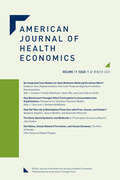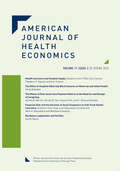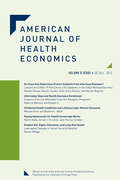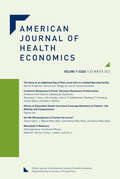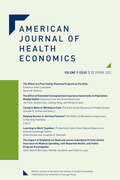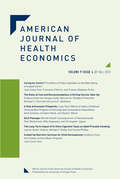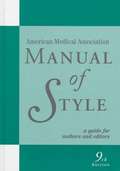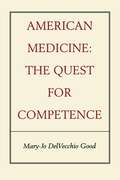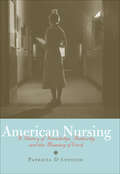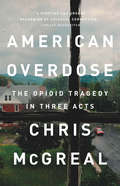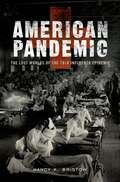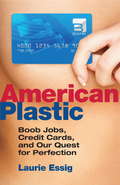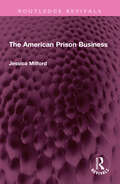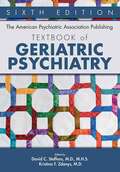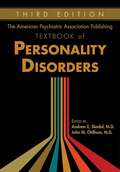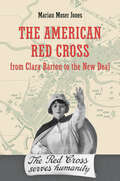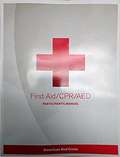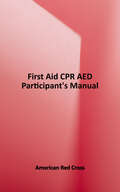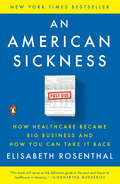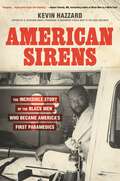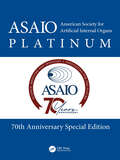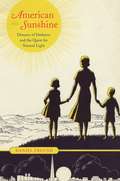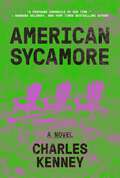- Table View
- List View
American Journal of Health Economics, volume 11 number 1 (Winter 2025)
by American Journal of Health EconomicsThis is volume 11 issue 1 of American Journal of Health Economics. The American Journal of Health Economics (AJHE) provides a forum for the in-depth analysis of health care markets and individual health behaviors. The articles appearing in AJHE are authored by scholars from universities, private research organizations, government, and industry. Subjects of interest include competition among private insurers, hospitals, and physicians; impacts of public insurance programs; pharmaceutical innovation and regulation; medical device supply; the rise of obesity and its consequences; the influence and growth of aging populations; and much more. The journal is published for the American Society of Health Economists (ASHEcon), which is a professional, non-profit organization dedicated to promoting excellence in health economics research in the United States.
American Journal of Health Economics, volume 11 number 2 (Spring 2025)
by American Journal of Health EconomicsThis is volume 11 issue 2 of American Journal of Health Economics. The American Journal of Health Economics (AJHE) provides a forum for the in-depth analysis of health care markets and individual health behaviors. The articles appearing in AJHE are authored by scholars from universities, private research organizations, government, and industry. Subjects of interest include competition among private insurers, hospitals, and physicians; impacts of public insurance programs; pharmaceutical innovation and regulation; medical device supply; the rise of obesity and its consequences; the influence and growth of aging populations; and much more. The journal is published for the American Society of Health Economists (ASHEcon), which is a professional, non-profit organization dedicated to promoting excellence in health economics research in the United States.
American Journal of Health Economics, volume 8 number 4 (Fall 2022)
by American Journal of Health EconomicsThis is volume 8 issue 4 of American Journal of Health Economics. The American Journal of Health Economics (AJHE) provides a forum for the in-depth analysis of health care markets and individual health behaviors. The articles appearing in AJHE are authored by scholars from universities, private research organizations, government, and industry. Subjects of interest include competition among private insurers, hospitals, and physicians; impacts of public insurance programs; pharmaceutical innovation and regulation; medical device supply; the rise of obesity and its consequences; the influence and growth of aging populations; and much more. The journal is published for the American Society of Health Economists (ASHEcon), which is a professional, non-profit organization dedicated to promoting excellence in health economics research in the United States.
American Journal of Health Economics, volume 9 number 1 (Winter 2023)
by American Journal of Health EconomicsThis is volume 9 issue 1 of American Journal of Health Economics. The American Journal of Health Economics (AJHE) provides a forum for the in-depth analysis of health care markets and individual health behaviors. The articles appearing in AJHE are authored by scholars from universities, private research organizations, government, and industry. Subjects of interest include competition among private insurers, hospitals, and physicians; impacts of public insurance programs; pharmaceutical innovation and regulation; medical device supply; the rise of obesity and its consequences; the influence and growth of aging populations; and much more. The journal is published for the American Society of Health Economists (ASHEcon), which is a professional, non-profit organization dedicated to promoting excellence in health economics research in the United States.
American Journal of Health Economics, volume 9 number 2 (Spring 2023)
by American Journal of Health EconomicsThis is volume 9 issue 2 of American Journal of Health Economics. The American Journal of Health Economics (AJHE) provides a forum for the in-depth analysis of health care markets and individual health behaviors. The articles appearing in AJHE are authored by scholars from universities, private research organizations, government, and industry. Subjects of interest include competition among private insurers, hospitals, and physicians; impacts of public insurance programs; pharmaceutical innovation and regulation; medical device supply; the rise of obesity and its consequences; the influence and growth of aging populations; and much more. The journal is published for the American Society of Health Economists (ASHEcon), which is a professional, non-profit organization dedicated to promoting excellence in health economics research in the United States.
American Journal of Health Economics, volume 9 number 3 (Summer 2023)
by American Journal of Health EconomicsThis is volume 9 issue 3 of American Journal of Health Economics. The American Journal of Health Economics (AJHE) provides a forum for the in-depth analysis of health care markets and individual health behaviors. The articles appearing in AJHE are authored by scholars from universities, private research organizations, government, and industry. Subjects of interest include competition among private insurers, hospitals, and physicians; impacts of public insurance programs; pharmaceutical innovation and regulation; medical device supply; the rise of obesity and its consequences; the influence and growth of aging populations; and much more. The journal is published for the American Society of Health Economists (ASHEcon), which is a professional, non-profit organization dedicated to promoting excellence in health economics research in the United States.
American Journal of Health Economics, volume 9 number 4 (Fall 2023)
by American Journal of Health EconomicsThis is volume 9 issue 4 of American Journal of Health Economics. The American Journal of Health Economics (AJHE) provides a forum for the in-depth analysis of health care markets and individual health behaviors. The articles appearing in AJHE are authored by scholars from universities, private research organizations, government, and industry. Subjects of interest include competition among private insurers, hospitals, and physicians; impacts of public insurance programs; pharmaceutical innovation and regulation; medical device supply; the rise of obesity and its consequences; the influence and growth of aging populations; and much more. The journal is published for the American Society of Health Economists (ASHEcon), which is a professional, non-profit organization dedicated to promoting excellence in health economics research in the United States.
American Medical Association Manual of Style: A Guide for Authors and Editors (9th edition)
by Cheryl IversonThe latest edition features an expanded chapter on legal and ethical concerns in publishing. Readers will also find an extensive chapter on statistics, a completely updated chapter on nomenclature, new policies for eponyms and numbers styles, a larger references section, an expanded discussion of inclusive language and abbreviations, and a larger section on figures and tables. A new section on typography is also featured, along with current information on electronic publishing, encompassing rapid changes affecting the publishing environment. End-of-chapter references make the book easier to use, and the entire text is reviewed by more than 70 editors for accuracy and dependability.
American Medicine: The Quest for Competence
by Mary-Jo DelVecchio GoodWhat does it mean to be a good doctor in America today? How do such challenges as new biotechnologies, the threat of malpractice suits, and proposed health-care reform affect physicians' ability to provide quality care?These and many other crucial questions are examined in this book, the first to fully explore the meaning and politics of competence in modern American medicine. Based on Mary-Jo DelVecchio Good's recent ethnographic studies of three distinct medical communities—physicians in rural California, academics and students involved in Harvard Medical School's innovative "New Pathway" curriculum, and oncologists working on breast cancer treatment—the book demonstrates the centrality of the issue of competence throughout the medical world. Competence, it shows, provides the framework for discussing the power struggles between rural general practitioners and specialists, organizational changes in medical education, and the clinical narratives of high-technology oncologists. In their own words, practitioners, students, and academics describe what competence means to them and reveal their frustration with medical-legal institutions, malpractice, and the limitations of peer review and medical training.Timely and provocative, this study is essential reading for medical professionals, academics, anthropologists, and sociologists, as well as health-care policymakers.
American Nursing: A History of Knowledge, Authority, and the Meaning of Work
by Patricia D'AntonioFirst Place, History and Public Policy, 2010 American Journal of Nursing Book of the Year AwardsThis new interpretation of the history of nursing in the United States captures the many ways women reframed the most traditional of all gender expectations—that of caring for the sick—to create new possibilities for themselves, to renegotiate the terms of some of their life experiences, and to reshape their own sense of worth and power. For much of modern U.S. history, nursing was informal, often uncompensated, and almost wholly the province of female family and community members. This began to change at the end of the nineteenth century when the prospect of formal training opened for women doors that had been previously closed. Nurses became respected professionals, and becoming a formally trained nurse granted women a range of new social choices and opportunities that eventually translated into economic mobility and stability. Patricia D'Antonio looks closely at this history—using a new analytic framework and a rich trove of archival sources—and finds complex, multiple meanings in the individual choices of women who elected a nursing career. New relationships and social and professional options empowered nurses in constructing consequential lives, supporting their families, and participating both in their communities and in the health care system. Narrating the experiences of nurses, D'Antonio captures the possibilities, power, and problems inherent in the different ways women defined their work and lived their lives. Scholars in the history of medicine, nursing, and public policy, those interested in the intersections of identity, work, gender, education, and race, and nurses will find this a provocative book.
American Overdose: The Opioid Tragedy in Three Acts
by Chris McGrealA comprehensive portrait of a uniquely American epidemic--devastating in its findings and damning in its conclusionsThe opioid epidemic has been described as "one of the greatest mistakes of modern medicine." But calling it a mistake is a generous rewriting of the history of greed, corruption, and indifference that pushed the US into consuming more than 80 percent of the world's opioid painkillers.Journeying through lives and communities wrecked by the epidemic, Chris McGreal reveals not only how Big Pharma hooked Americans on powerfully addictive drugs, but the corrupting of medicine and public institutions that let the opioid makers get away with it.The starting point for McGreal's deeply reported investigation is the miners promised that opioid painkillers would restore their wrecked bodies, but who became targets of "drug dealers in white coats."A few heroic physicians warned of impending disaster. But American Overdose exposes the powerful forces they were up against, including the pharmaceutical industry's coopting of the Food and Drug Administration and Congress in the drive to push painkillers--resulting in the resurgence of heroin cartels in the American heartland. McGreal tells the story, in terms both broad and intimate, of people hit by a catastrophe they never saw coming. Years in the making, its ruinous consequences will stretch years into the future.
American Pandemic: The Lost Worlds of the 1918 Influenza Epidemic
by Nancy K. BristowThis readable and compelling account explains the role of race, gender and class, promotion of physical fitness and public education, and America's public health strategy during the influenza epidemics in 1918, 1919, 1920, and 1922. Bristow's work distinguishes itself with her emphasis on influenza epidemics beyond 1918-1919, the roles of physicians and nurses, the importance of public health nursing, and the personal revelation that she lost great-grandparents due to influenza.
American Plastic
by Laurie EssigThe riveting story of how cosmetic surgery and plastic money melted together to create a subprime mortgage crisis of the body Plastic surgery has become "the answer" for many Americans, and in American Plastic sociologist Laurie Essig explores how we arrived at this particular solution. Over the last decade there has been a 465 percent increase in cosmetic work, and we now spend over $12 billion annually on procedures like liposuction, face-lifts, tummy tucks, and boob jobs. In this fascinating book, Essig argues that this transformation is the result of massive shifts in both our culture and our economy--a perfect storm of greed, desire, and technology. Plastic is crucial to who we are as Americans, Essig observes. We not only pioneered plastic money but lead the world in our willingness to use it. It's estimated that 30 percent of plastic surgery patients earn less than $30,000 a year; another 41 percent earn less than $60,000. And since the average cost of cosmetic work is $8,000, a staggering 85 percent of patients assume debt to get work done. Using plastic surgery as a lens on better understanding our society, Essig shows how access to credit, medical advances, and the pressures from an image- and youth-obsessed culture have led to an unprecedented desire to "fix" ourselves.
The American Prison Business (Routledge Revivals)
by Jessica MitfordFirst published in 1974, The American Prison Business studies the lunacies, the delusions, and the bizarre inner workings of the American prison business. From the first demonstration that the penitentiary is an American invention that was initiated by the late eighteenth-century reformers, to the startling revelations, in the chapter called ‘Cheaper than Chimpanzees’ of how pharmaceutical companies lease prisoners as human guinea-pigs, every page stimulates and surprises the reader as Jessica Mitford describes, inter alia the chemical, surgical and psychiatric techniques used to help ‘violent’ prisoners to be ‘reborn’; why businessmen tend to be more enthusiastic than the prisoners they employ in the ‘rent-a-con’ plan; and the Special Isolation Diet which tastes like inferior dog food. Jessica Mitford’s financial analysis of the prison business is a scoop. Her hard-eyed examination of how parole really works is a revelation. As the prison abolition movement continues to gain momentum, this book will provide food for thought for legislators, officials and students of sociology, law, criminology, penology, and history.
The American Psychiatric Association Publishing Textbook Of Geriatric Psychiatry
by Kristina F. Zdanys David C. SteffensOver the course of more than two decades and five previous editions, The American Psychiatric Association Publishing Textbook of Geriatric Psychiatry has established itself as a foundational resource in the field. This new edition retains the multidisciplinary and developmental perspectives of its predecessors, drawing on the knowledge not only of psychiatrists but also of relevant biomedical and behavioral experts in order to present the most comprehensive approach to patient care. It has been extensively updated to reflect the latest scientific advances and clinical developments in the field. Not only will readers find the most up-to-date information on phenomenology, diagnosis, and assessment of late-life mental disorders, they will also access the latest research on psychotherapeutic, psychopharmacological, and other somatic treatments. A dedicated chapter delves into the role of technology―including digital phenotyping, wearables, digital and Web-based neurocognitive testing, and more―in aiding the geriatric mental health workforce and improving both access to care and ongoing support. Throughout the book, several sections also candidly examine the impact of COVID-19, and its attendant social isolation, on older adult mental health and the evolution of treatment approaches, revealing insights learned about telepsychiatry and care in nursing homes during the pandemic. Chapters on the legal and ethical factors in the psychiatric care of older adults close out the book, the most exhaustive on the topic. Extensively researched and with key points for ease of reference, this edition will equip both the scholar and the clinician with the current state of scientific understanding as well as the practical skills and knowledge base required for dealing with mental disorders in late life.
The American Psychiatric Association Publishing Textbook Of Personality Disorders
by Andrew E. Skodol John M. OldhamThe subject of personality―what makes each of us unique and different from one another―has long been a topic of universal fascination. From a medical perspective, research on personality disorders has expanded with the advent of standardized diagnostic systems. This continuing and increased activity and progress in the field spurred the development of this third edition of The American Psychiatric Association Publishing Textbook of Personality Disorders. With an emphasis on updating the information most relevant to clinicians, this new edition features contributions from established experts in the field as well as a new generation of scientists. Dozens of tables, illustrative figures, and real-life case examples summarize the vast data that continue to accumulate in five key areas: • Clinical concepts, including theories of personality disorders, as well as their manifestations, assessment, and diagnosis. This opening section also describes the Alternative DSM-5 Model for Personality Disorders in detail.• Risk factors for, and the etiology and impact of, personality disorders. This section of the book examines data on prevalence, sociodemographics, and levels of functional impairment associated with personality disorders. It offers both a developmental and a genetic/neurobiological perspective and describes the symptomatic and functional outcomes of personality disorders.• Treatment options across therapeutic modalities. A new, cutting-edge chapter argues for the early identification of borderline psychopathology in children and young adolescents, in an effort to prevent full-blown disorder later in life. Additional chapters delve into an array of individual psychotherapies, pharmacotherapeutic options, and group, family, and couples therapies. Guidance on forming and maintaining a therapeutic alliance and on avoiding boundary violations in treating patients with personality disorders is provided.• Special problems, populations, and settings, including suicide, substance use disorders, antisocial behavior, personality pathology in general medical settings, and personality disorders among active-duty military.• The usefulness of translational research to deepen understanding of the biopsychosocial nature of the personality disorders, particularly borderline personality disorder. This comprehensive textbook is an essential resource for clinicians looking to stay on the vanguard of a rapidly growing field.
The American Red Cross: From Clara Barton to the New Deal
by Marian Moser JonesThe iconic relief organization&’s activities over a half century of history, through wars, epidemics, and other disasters: &“Well-researched . . . fascinating.&” —Julia F. Irwin, Bulletin of the History of Medicine In dark skirts and bloodied boots, Clara Barton fearlessly ventured onto Civil War battlefields to tend to wounded soldiers. She later worked with civilians in Europe during the Franco-Prussian War, lobbied legislators to ratify the Geneva conventions, and founded and ran the American Red Cross. The American Red Cross from Clara Barton to the New Deal tells the story of the charitable organization from its start in 1881, through its humanitarian aid during wars, natural disasters, and the Depression, to its relief efforts of the 1930s. Marian Moser Jones illustrates the tension between the organization&’s founding principles of humanity and neutrality and the political, economic, and moral pressures that sometimes caused it to favor one group at the expense of another. This book tells the stories of: • U.S. natural disasters such as the Jacksonville yellow fever epidemic of 1888, the Sea Islands hurricane of 1893, and the 1906 San Francisco earthquake • crises abroad, including the 1892 Russian famine and the Armenian massacres of 1895–96 • efforts to help civilians affected by the civil war in Cuba • power struggles within the American Red Cross leadership and subsequent alliances with the American government • the organization&’s expansion during World War I • race riots and massacres in East St. Louis, Chicago, and Tulsa between 1917 and 1921 • help for African American and white Southerners after the Mississippi flood of 1927 • relief projects during the Dust Bowl and after the New Deal An epilogue relates the history of the American Red Cross since the beginning of World War II and illuminates the organization&’s current practices and international reputation.
American Red Cross First Aid/CPR/AED: Participant’s Manual
by American Red CrossThis participant's manual is part of the American Red Cross First Aid/ CPR/AED program. This manual contains three parts: 1. First Aid Basics; 2. First Aid for Cardiac Emergencies and Choking; and 3. First Aid for Common Illnesses and Injuries.
American Red Cross First Aid/ CPR/ AED Participant's Manual
by American Red CrossThe American Red Cross First Aid/CPR/AED Participant’s Manual supports the courses in the American Red Cross First Aid/CPR/AED program, to teach participants the knowledge and skills needed to give immediate care to an injured or ill person and to decide whether advanced medical care is needed. This manual contains information about recognizing an emergency, the emergency action steps, recognizing cardiac arrest, signs of a heart attack, giving CPR, the cardiac chain of survival, how to use an AED, care for choking, and care for sudden illnesses and other life-threatening injuries. As well as the information and skills needed to assist with an asthma inhaler, epinephrine auto-injector, splinting, tourniquet application, and naloxone administration. This program offers a choice of first aid, CPR and AED courses to meet the various training needs of a diverse audience. The care steps in the program are consistent with the 2020 International Liaison Committee on Resuscitation (ILCOR) Consensus on Science and Treatment Recommendations for CPR and Emergency Cardiovascular Care (ECC) and the 2020 American Heart Association and American Red Cross Guidelines for CPR and First Aid.
The American Red Cross from Clara Barton to the New Deal
by Marian Moser JonesThe American Red Cross is an iconic institution whose long history includes both controversy and achievement.In dark skirts and bloodied boots, Clara Barton fearlessly ventured on to Civil War battlefields to tend to wounded soldiers. She later worked with civilians in Europe during the Franco-Prussian War, lobbied legislators to ratify the Geneva conventions, and founded and ran the American Red Cross. The American Red Cross from Clara Barton to the New Deal tells the story of the charitable organization from its start in 1881, through its humanitarian aid during wars, natural disasters, and the Depression, to its relief efforts of the 1930s.Marian Moser Jones illustrates the tension between the organization's founding principles of humanity and neutrality and the political, economic, and moral pressures that sometimes caused it to favor one group at the expense of another. This expansive book narrates the stories of: • U.S. natural disasters such as the Jacksonville yellow fever epidemic of 1888, the Sea Islands hurricane of 1893, and the 1906 San Francisco earthquake• crises abroad, including the 1892 Russian famine and the Armenian massacres of 1895–96• efforts to help civilians affected by the civil war in Cuba• power struggles within the American Red Cross leadership and subsequent alliances with the American government• the organization's expansion during World War I• race riots in East St. Louis, Chicago, and Tulsa between 1917 and 1921• help for African American and white Southerners after the Mississippi flood of 1927• relief projects during the Dust Bowl and after the New DealAn epilogue relates the history of the American Red Cross since the beginning of World War II and illuminates the organization's current practices as well as its international reputation.
An American Sickness: How Healthcare Became Big Business and How You Can Take It Back
by Elisabeth Rosenthal<P>At a moment of drastic political upheaval, a shocking investigation into the dangerous, expensive, and dysfunctional American healthcare system, as well as solutions to its myriad of problems In these troubled times, perhaps no institution has unraveled more quickly and more completely than American medicine. <P>In only a few decades, the medical system has been overrun by organizations seeking to exploit for profit the trust that vulnerable and sick Americans place in their healthcare. Our politicians have proven themselves either unwilling or incapable of reining in the increasingly outrageous costs faced by patients, and market-based solutions only seem to funnel larger and larger sums of our money into the hands of corporations. Impossibly high insurance premiums and inexplicably large bills have become facts of life; fatalism has set in. Very quickly Americans have been made to accept paying more for less. How did things get so bad so fast? <P> Breaking down this monolithic business into the individual industries—the hospitals, doctors, insurance companies, and drug manufacturers—that together constitute our healthcare system, Rosenthal exposes the recent evolution of American medicine as never before. How did healthcare, the caring endeavor, become healthcare, the highly profitable industry? <P>Hospital systems, which are managed by business executives, behave like predatory lenders, hounding patients and seizing their homes. Research charities are in bed with big pharmaceutical companies, which surreptitiously profit from the donations made by working people. Patients receive bills in code, from entrepreneurial doctors they never even saw. The system is in tatters, but we can fight back. Dr. Elisabeth Rosenthal doesn't just explain the symptoms, she diagnoses and treats the disease itself. <P>In clear and practical terms, she spells out exactly how to decode medical doublespeak, avoid the pitfalls of the pharmaceuticals racket, and get the care you and your family deserve. She takes you inside the doctor-patient relationship and to hospital C-suites, explaining step-by-step the workings of a system badly lacking transparency. <P>This is about what we can do, as individual patients, both to navigate the maze that is American healthcare and also to demand far-reaching reform. An American Sickness is the frontline defense against a healthcare system that no longer has our well-being at heart. <P><b>A New York Times Bestseller</b>
American Sirens: The Incredible Story of the Black Men Who Became America's First Paramedics
by Kevin HazzardThe extraordinary story of an unjustly forgotten group of Black men in Pittsburgh who became the first paramedics in America, saving lives and changing the course of emergency medicine around the world Until the 1970s, if you suffered a medical crisis, your chances of survival were minimal. A 9-1-1 call might bring police or even the local funeral home. But that all changed with Freedom House EMS in Pittsburgh, a group of Black men who became America&’s first paramedics and set the gold standard for emergency medicine around the world, only to have their story and their legacy erased—until now.In American Sirens, acclaimed journalist and paramedic Kevin Hazzard tells the dramatic story of how a group of young, undereducated Black men forged a new frontier of healthcare. He follows a rich cast of characters that includes John Moon, an orphan who found his calling as a paramedic; Peter Safar, the Nobel Prize-nominated physician who invented CPR and realized his vision for a trained ambulance service; and Nancy Caroline, the idealistic young doctor who turned a scrappy team into an international leader. At every turn, Freedom House battled racism—from the community, the police, and the government. Their job was grueling, the rules made up as they went along, their mandate nearly impossible—and yet despite the long odds and fierce opposition, they succeeded spectacularly. Never-before revealed in full, this is a rich and troubling hidden history of the Black origins of America&’s paramedics, a special band of dedicated essential workers, who stand ready to serve day and night on the line between life and death for every one of us.
American Society for Artificial Internal Organs (ASAIO) Platinum 70th Anniversary Special Edition
by Pramod BondeThis book celebrates two decades of groundbreaking research published in the ASAIO Journal, marking significant advancements in artificial organs and circulatory support.The American Society for Artificial Internal Organs ASAIO Platinum 70th Anniversary book is a compilation of 50 of the top papers published in the ASAIO Journal over the last two decades that have contributed to the evolution of the field. The book includes tables listing the Top 100- cited, viewed, and downloaded, articles from the ASAIO Journal. It also lists the Top 10 Altmetric Scores by Year, 2015-2024. Topics range from artificial vision for the blind, and control systems for blood glucose, to the development of an artificial placenta IV and engineering 3D bio-artificial heart muscle, and much more. This book represents early ideas and concepts, new treatments and devices that changed future clinical care and some early concepts that challenge the status quo. With contributions from leading experts, the ASAIO 70th Anniversary Book serves as a comprehensive resource for anyone interested in the forefront of artificial organ technology and its impact on improving patient outcomes.This book is intended for clinicians, scientists, engineers, and academics working for the advancement and development of innovative medical device technologies.
American Sunshine: Diseases of Darkness and the Quest for Natural Light
by Daniel FreundIn the second half of the nineteenth century, American cities began to go dark. Hulking new buildings overspread blocks, pollution obscured the skies, and glass and smog screened out the health-giving rays of the sun. Doctors fed anxities about these new conditions with claims about a rising tide of the "diseases of darkness," especially rickets and tuberculosis. In American Sunshine, Daniel Freund tracks the obsession with sunlight from those bleak days into the twentieth century. Before long, social reformers, medical professionals, scientists, and a growing nudist movement proffered remedies for America’s new dark age. Architects, city planners, and politicians made access to sunlight central to public housing and public health. and entrepreneurs, dairymen, and tourism boosters transformed the pursuit of sunlight and its effects into a commodity. Within this historical context, Freund sheds light on important questions about the commodification of health and nature and makes an original contribution to the histories of cities, consumerism, the environment, and medicine.
American Sycamore: A Novel
by Charles KenneyA moving novel about the devotions of friendship and the power of love to heal, American Sycamore celebrates the American experiment and the importance of giving a damn. Rob Barrow&’s devotion to the American experiment has never wavered. For forty years he has devoted his legal brilliance to advancing the essential American ideals enshrined by the Founders. Rob is the best kind of throwback—a classic American character, reserved and respectful, yet with a fierce determination to protect the people and ideas that matter most. Rob stands his ground. He does not yield to the ridicule of malign political forces, nor to the mounting challenges of aging—loss, grief, even an invasion of rogue cells. While AMERICAN SYCAMORE is Rob&’s story, it is also the story of his beloved wife Julia, an author who believes America has lost her way and seeks to understand why. It is the story of their dearest friend, Dr. Ray Witter, a battlefield surgeon in Vietnam and now the medical school dean. When we first meet Rob, Julia, and Ray in graduate school during the 1970s, they are on the idealistic mission to make things right in America. A sense of purpose animates their lives while a commitment to each other powers them through the decades strengthening their bond along the way. AMERICAN SYCAMORE celebrates what ennobles and buoys us—always welcome, but especially so in these mad times. The novel will appeal to readers of literary fiction and upmarket commercial fiction including character-driven mysteries. This is a novel for readers drawn to complex characters facing life&’s challenges with grace and the power of shared love and friendship. It is a story that unfolds on several different levels with surprising twists and turns and, ultimately, a mystery at the heart of the matter.
